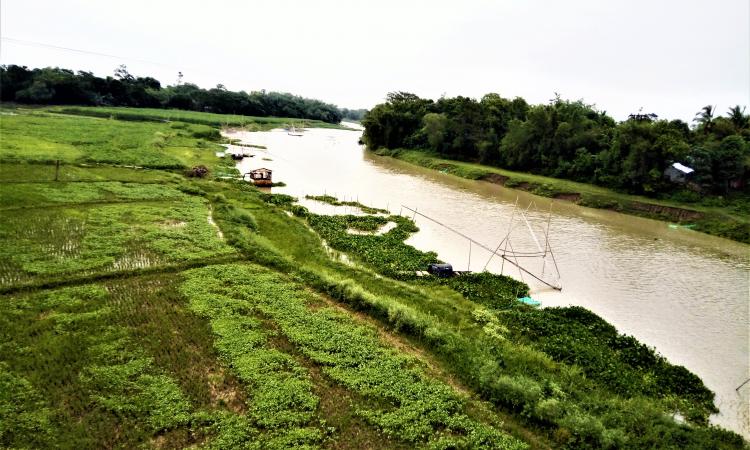
India is dealing with a growing water stress crisis brought on by things like climate change, population growth, pollution, and changes in land use. Currently, there are about 1400 cubic metres of water available per person, but by 2050, that number is predicted to fall to 1200 cubic metres. Already, a large portion of India is deemed to be water-stressed. Agriculture, which depends heavily on water resources, adds to this strain.
Large international rivers, which are essential for India's 1.4 billion people who depend on agriculture, are under extreme stress as a result of climate change, population growth, unrestrained water use, and pollution. The Indian summer monsoon (ISM), which accounts for 80% of yearly rainfall and affects GDP, is essential. However, there have been changes to the Indian summer monsoon, including a decrease in the mean rainfall and an increase in extreme events, which has increased hydrologic extremes and disasters.
India suggests interlinking projects with large canals and reservoirs to address these problems by moving water between basins with surpluses and deficits. With a proposed budget of USD 168 billion, this ambitious plan seeks to offer advantages like flood control, drought mitigation, and hydropower generation. Its potential ecological effects, including those on fish diversity and aquatic ecosystems, are cause for concern.
This study, ‘River interlinking alters land-atmosphere feedback and changes the Indian summer monsoon’ by Tejasvi Chauhan et al., introduces the concept of exploring feedback from inter-basin water transfer to the water cycle. According to the hypothesis, water transfer could have an effect on nearby basins through land-atmosphere feedback, especially given how strongly the land interacts with the atmosphere in the Indian region.
Without a thorough understanding of the hydro-meteorological effects, these projects involve the transfer of water through reservoirs and canals from river basins that are in surplus to those that are in deficit.
The authors demonstrate how land-atmosphere feedbacks produce causal pathways between river basins in India using causal delineation techniques, a coupled regional climate model, and multiple reanalysis datasets. The analysis disproves the conventional assumption of independence when planning hydrological projects by showing how river basins are connected through feedback between the land and atmosphere.
The study also suggests that river interlinking initiatives in India may have an impact on the Indian summer monsoon, potentially reducing September rainfall in arid regions and escalating water stress. This research highlights the significance of taking atmospheric variables into account in large-scale hydrological projects and offers a ground-breaking scientific assessment of the interconnectedness of river basins.
The results provide understanding of potential effects of river interlinking, emphasising the need for a careful balance between ecological sustainability and meeting water needs.
Results and discussion
The inter-basin water transfer's effects on land water management have an effect on the spatial distribution of rainfall in distant basins. As a result of high evapotranspiration during periods of high soil moisture (SM), the intra-basin land-atmosphere connection results in surface cooling. Soil moisture contributes to the moisture content of the air in this way.
The moisture supplied by evapotranspiration may result in recycled precipitation in the same basin or may be carried by the wind to distant regions, which may change the region's precipitation patterns. The thermal contrast between the ocean and land or between various land regions is altered by evaporative cooling, which also alters wind patterns, which in turn alters moisture transport and rainfall.

The study hypothesises that the proposed river-interlinking projects in India can cause land-atmosphere feedbacks, perturbing the Indian Summer Monsoon (ISM) and affecting spatial precipitation patterns. To test this, the researchers employed the WRF-CLM4 coupled land-atmosphere model, focusing on the ISM period from 1991 to 2012. They compared a control run (CTL) representing current irrigation practices with an irrigation run (IRR) simulating an 80% increase in irrigated area as targeted by interlinking projects.
Results revealed significant changes in September precipitation due to land-atmosphere feedback. The spatial distribution of mean percentage change in September rainfall for various regions in India showed statistically significant declines in central India, east peninsular India, coastal Gujarat, east-central India, the dry western region of Rajasthan, and the western Himalayan foothills. Conversely, east India and parts of the Deccan plateau experienced increases. The study finds that increased irrigation from the transferred water reduces mean rainfall in September by up to 12% in already water-stressed regions of India.
The study also looked at how it affected soil moisture and temperature, finding that areas with less precipitation experienced changing meteorological patterns, temperature increases, and declining soil moisture.
The study also took El Nino and La Nina years into account, and it discovered that La Nina years had more pronounced soil moisture drying. While the arid western region of India declined regardless of ENSO phase, the central Indian regions improved during El Nino years.
The decrease in September rainfall may worsen water stress, affecting areas that depend on agriculture and putting more people at risk from climate change. The study emphasises the necessity of reassessing water balance in connected river basins while taking the effects of land-atmosphere feedback into account. The socioeconomic circumstances in the affected areas determine how severe the water stress is.
The study also acknowledges that reported inter-basin links may alter in the future as a result of climate change and changes in land use. The results emphasize the necessity of model-guided impact assessment studies of significant hydrological projects globally.
Citation: Tejasvi Chauhan et al, River interlinking alters land-atmosphere feedback and changes the Indian summer monsoon, Nature Communications (2023). DOI: 10.1038/s41467-023-41668-x
/articles/interlinking-rivers-can-influence-dynamics-indian-summer-monsoon